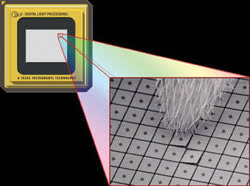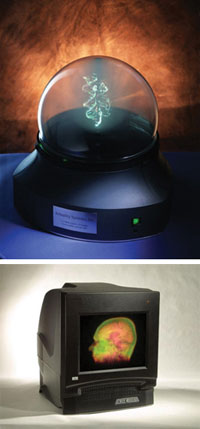Three-dimensional visualization, medical imaging and data storage are just a few of the application areas that use the power of high-speed binary light.
Dana Dudley, Texas Instruments Inc.
Digital light processing (DLP), which has gained wide acceptance in light modulation for video and data projectors and big-screen high-definition TVs, now enables dozens of emerging applications, including lithography, scientific instrumentation, medical imaging and engraving.
At the heart of this technology is the digital micromirror, an array of tiny (13.7 × 13.7 μm) bistable mirrors that can switch light in microseconds. These optical switching speeds not only enable amazing image clarity in projection products, but also provide the versatility to be the light modulator of choice in many other applications.

Figure 1. The minute size of a DLP light modulator device can be illustrated by comparing the magnified images of a micromirror array and an ant’s leg.
This light modulator is an array of hundreds of thousands of moving micromirrors that are controlled by underlying CMOS electronics (Figure 1). The mirrors are designed to rotate to either a +12° or –12° position, depending on the binary state of the CMOS memory cell below each mirror. The memory voltage is applied to the address electrodes, creating an electrostatic attraction. When a voltage pulse is applied to the mirrors, each one either stays in place or quickly rotates to its opposite state according to the memory data. Once stabilized, the mirror can be considered electromechanically “latched” in its desired position, and the underlying memory data can then be changed without affecting the state of the mirror.
The mirrors are highly reflective and are manufactured with submicron mirror-to-mirror gaps. This architecture, coupled with the microsecond mirror switching speed, makes the technology very efficient at switching light with high precision and with a high-optical-contrast ratio. The efficiency is crucial not only for display applications, but also for emerging applications such as lithography and data storage. The technology uses standard silicon wafer processing and equipment, and the mirrors can operate continuously at high speeds for more than 100,000 hours.
Digital fidelity
DLP projectors and projection TVs are known for having high-fidelity images that do not degrade with time. Images made with this technology are created through binary pulsewidth modulation, where intensity levels for each pixel are produced through short flashes of light with durations precisely controlled by digital electronics and rapid micromirror transitions. Even though the eye cannot follow this short-burst timing, human beings can discern small changes in duration by integrating the average amount of light emitted from a pixel, effectively acting as an array of high-precision analog-to-digital converters.
Because of this link between picture fidelity and light-modulation speed, engineers at Texas Instruments Inc. in Plano, Texas, are pushing this technology to higher mirror speeds and data bandwidths. It is being used in dozens of other applications, many of which do not require gray scale, but instead focus on optical rendering of binary information. These light modulators can display 10,000 to 15,000 binary information frames each second. With 768 rows of 1024 mirrors, that’s about 10 Gb/s of digital light.
This capability is what makes the technology so uniquely powerful. Inventors and developers of photonic systems have integrated it into lithography and photofinishing products. There also are dozens of other applications, most requiring support electronics that are more flexible than those used in projectors. Although these projector support chips are largely responsible for the amazing picture quality for which these products are renowned, their specialized algorithms and timing can actually inhibit nondisplay applications.
3-D display
One emerging application is volumetric display, in which DLP light modulators are used to render 3-D images that appear to float in space without the use of encumbering stereo glasses or headsets. The Perspecta from Actuality Systems Inc. of Burlington, Mass., creates 10-in.-diameter 3-D imagery within a transparent sphere that allows observers to walk around an interactive 3-D image to achieve a 360° perspective (Figure 2 top). Three micromirror arrays, one for each primary color, project binary color images onto a rotating screen, creating more than 100 million voxels (3-D pixels) with spatial dithering to create hundreds of colors.

Figure 2. Actuality Systems’ Perspecta (top) and LightSpace Technologies’ DepthCube (bottom) are volumetric displays that use DLP light modulators to create 3-D images viewed without glasses or headsets.
The DepthCube display from LightSpace Technologies Inc. of Norwalk, Conn., and Borlange, Sweden, is a 19.5-in. computer graphics display that uses three of these light modulators to project 2-D images sequentially on 20 back-to-back liquid crystal panels (Figure 2 bottom). The result is a solid-state volumetric display featuring 15.3 million voxels and more than 32,000 colors.
The vastly different formats of each of these systems demonstrate both the performance and versatility of the technology. Gigabit-per-second light-switching capability enables the system developer to make trade-offs over a wide range of color fidelity and 2-D frame rates.
Scientific tools
Newport Corp. of Irvine, Calif., recently brought to market its LambdaCommander, a programmable spectral processor. In this product, fiber optic light is spectrally dispersed across the micromirror array by a grating, and the mirrors are employed to spatially attenuate specific wavelengths prior to being recombined into an output fiber.
This award-winning instrument allows input broadband radiation to be customized in real time to just about any output spectral profile. Its applications include subnanometer spectral shaping, fiber sensing, spectral gain flattening, optical coherence tomography, optical filter testing and advanced telecommunications development.
This is the first of what is hoped to be a number of important scientific instruments to use DLP technology as a spatial or spectral filter. Consider the possibility of a micromirror array that can enable a new filter pattern to be realized more than 10,000 times each second. Someday, real-time multispectral imaging systems based on this technology will be used to image (and maybe even treat) cancer. Applications in machine vision and remote sensing also are on the horizon.
For years, the use of the technology has been considered for confocal and other forms of microscopy. In these applications, individual or groups of mirrors are addressed to shape or scan the illumination or collection aperture of an optical microscope, thus acting as a dynamic slit or pinhole and eliminating the need for cumbersome, low-performance mechanical scanning.
With the recent availability of electronics designed to support user-defined high-speed binary switching, revolutionary products in the microscopy area are expected to reach fruition in the near future. Just imagine what can be achieved when the multispectral imaging capability described above is coupled with the ability to optically section tissue through confocal microscopy. Now, combine all this with the ability to do this through an endoscope, and you can imagine an extremely powerful and versatile medical imaging system that saves lives and money.
Where next?
Although medical imaging tends to excite a “wow” response in most of us, many of these new applications will find use in scientific labs, manufacturing and maybe even security. Three-dimensional metrology enabled by digital light processing is expected to emerge in the near term. In the Z-Snapper instrument from Vialux GmbH in Chemnitz, Germany, this type of system is used to rapidly project a series of grid patterns on an object while a CCD camera synchronously captures the reflected patterns. The surface topology of the object is calculated from the contour patterns of the reflected images. This method should find its way not only into research labs, but also, because of its speed, into real-time inspection and security.
Besides the 3-D visualization and scientific markets, many other application areas are being developed by more than 100 companies and institutions. The range is broad and includes information technology areas, such as holographic data storage and telecommunications, and industrial applications as diverse as lithography, watermarking and engraving.
The challenge is not to try to predict which of these applications or customers will be most successful, but to enable as much activity as possible by making DLP technology available and easy to use. It’s possible that the most important application has yet to be conceived.
Meet the author
Dana Dudley is a product manager at Texas Instruments Inc.’s DLP Products Div. in Plano, Texas; e-mail: [email protected].